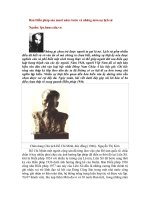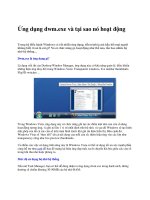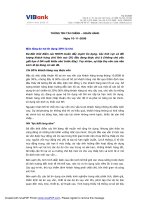Jake Bernstein no bull investing_6 pptx
Bạn đang xem bản rút gọn của tài liệu. Xem và tải ngay bản đầy đủ của tài liệu tại đây (675.1 KB, 23 trang )
INTRODUCING THE METHOD
It is difficult to write an investment guide that will be tailored
to the level of expertise of all investors. Some of you may be com-
pletely new to the stock market, while others will have had many
years of experience. If I begin at too basic a level, I run the risk
of alienating those with more experience. If I begin at too ad-
vanced a level, I’ll lose the beginner. Accordingly, please find
your place in the following list and act accordingly:
Ⅲ Complete newcomers to investing. If you have had no experi-
ence in the stock market, you need to learn the basic ter-
minology of the market. If you have no experience in real
estate, you’ll need a working knowledge in this area as well.
I suggest reading Stock Market Strategies That Work. It will
help you become acquainted with the basics and with many
of the important issues. There are other books for begin-
ners that may be more basic. It may take a little more time
for you to get started, but I urge you to build a sound base
of knowledge before you invest a single penny in stocks.
Ⅲ You have had some experience but . . . This category is one
step above being a newcomer, but it’s an important step
because you have learned some of the basics. Here again,
I recommend my book Stock Market Strategies That Work.
Ⅲ You’re an experienced investor. This means you have traded
in stocks, options, futures, or all of these. You have a good
understanding of the terminology used in stock investing
and trading. I suggest that you read my books, Momentum
Stock Selection (McGraw-Hill, 2001) and How to Trade the New
Single Stock Futures (Dearborn Trade, 2002). These books
will help you with the concepts discussed in this chapter.
106 NO BULL INVESTING
As an alternative, you may want go ahead with this chapter,
regardless of your experience level. If things don’t make sense
to you, then go back to the basics and read the recommended
books. Note that there are many books for beginners, so choose
one that you enjoy or that is more on your level of knowledge
and experience. Now let’s proceed with the topic at hand.
Many Different Methods
There are literally thousands of investment and trading
methods in the stock, options, and futures markets. Truth be
known, most of them are only marginally successful for various
and sundry reasons. If you can find a method that has been
profitable 50 percent of the time, and if you manage your losing
investments by exiting them quickly while you keep winning in-
vestments, you will do well in the long run. Few professional in-
vestors are correct a majority of the time. Too many investors are
preoccupied with the question, What percentage of the time has
your investment decision been correct? The question is not only
a foolish one, but it can also get you into trouble. The important
question is not how often has a system or methodology been
right, but rather how much money has an investment method
made for individuals at your financial level.
Consider the following scenarios:
Ⅲ Investor #1: Ten investments at 90 percent correct. One
investment lost money, the others made money.
Ⅲ Investor #2: Ten investments at 30 percent correct. Seven
investments lost money, only three made money.
THE METHOD 107
Which of these two is best? Most people would pick the in-
vestor #1 approach, but the choice would be impossible to make
without more information. Consider the following:
Ⅲ Investor #1: Ten investments at 90 percent correct. One
investment lost $2,000, the others made a total of $457 after
commissions. Net LOSS: $1,543.
Ⅲ Investor #2: Ten investments at 30 percent correct. Seven
investments lost a total of $2,500. Three investments made
a total of $5,000. Net PROFIT: $2,500.
Which of these two is best? Clearly the second choice is the
correct one. Note that for investor #1, accuracy was excellent
but the results were poor.
Investment Methods, Accuracy, and Risk
As you can see from the foregoing example, accuracy is not
the issue. If you have a method that is both accurate and prof-
itable, you have the best combination. Although this chapter is
about an investment method, I will tell you frankly that if you
manage your risk correctly, then virtually any method can make
you money if you follow some basic rules. These rules are dis-
cussed at the end of this chapter. I believe that the methods dis-
cussed in this book can boost your accuracy well over the 60
percent level. This advantage, combined with effective risk man-
agement, can give you excellent and consistent results for many
years.
108 NO BULL INVESTING
INTRODUCING MOMENTUM
There are many ways to measure the strength or weakness of
a stock. There are many ways in which we can attempt to deter-
mine if a stock is ready to go up or down. Momentum is one of
the many technical methods used to measure the strength or
weakness of a stock. I will use the abbreviation MOM for mo-
mentum. I like to think of MOM as a measure of underlying
market strength or weakness and of change in direction (or
trend). In fact, I like the analogy of fuel in a gas tank. If a stock
is going to continue to move higher, it must have sufficient fuel,
or momentum, to do so. If a stock or futures contract is going
to continue going down, it must have sufficient fuel, or momen-
tum, to push it lower. If a market is moving higher, while its mo-
mentum, as measured by the MOM indicator, is moving lower,
the market is in danger of topping. If a market is moving lower,
while its MOM indicator is moving higher, then the market is
developing a bottoming pattern.
Each of these conditions is defined as a divergent condition.
Divergence means moving in different directions. Markets that
are likely to change direction tend to develop divergence before
they change direction. Divergence does not always happen prior to a
change in the direction of a market, but it often does. Why is this
important? Because if you are going to make money on your
investments, you will want to buy when markets are either low
in price or likely to go up. And you will want to get out before
markets go down, or soon after they begin going down. You will
take your profits and put them into other investments using this
approach.
THE METHOD 109
The Normal Situation
First, let’s take a look at the “normal” conditions for price
and momentum. Figure 7.1 shows a normal uptrend (bull trend)
in which momentum and price are moving up together. This is
a “healthy” market, one in which a top is not likely at this time.
Figure 7.2 shows a declining trend (bear trend) in which price
and momentum are declining. This is also a “normal” pattern in
which the odds of a continued drop in price are quite good.
110 NO BULL INVESTING
FIGURE 7.1 This illustration shows momentum with price. Note that as price
moves higher, momentum moves higher. The “vehicle” has fuel behind it and, as
a result, a top is not imminent. Of course, this can change quickly, depending on
the behavior of the MOM indicator.
HOW TO CALCULATE MOMENTUM
Don’t let this scare you; MOM is simple to calculate. You do
not need to know how to calculate momentum, but if you want
to know, remember that it involves simple subtraction. In order to
get the MOM indicator, you simply subtract one day’s closing price
from the closing price X days ago. Here are a couple examples:
1. Ten-day momentum calculation for stock ABC. Price today:
64.10. Price ten days ago: 64.50. Momentum = 64.50 −
64.10, or −0.40. The momentum is NEGATIVE, because
the price today was lower today than ten days ago.
THE METHOD 111
FIGURE 7.2 The relationship between momentum and price as price declines.
As price moves down, momentum becomes more negative, suggesting that
there is still power behind the declining trend.
2. Ten-day momentum calculation for stock XYZ. Price today:
2.22. Price ten days ago: 2.18. Momentum = 2.22 − 2.18,
or +4.0. The momentum is POSITIVE, because the price
today was higher than ten days ago. Momentum is zero if
the price today is the same as it was X days ago.
Some trading software and charting programs use the Rate
of Change (ROC) instead of the MOM. The calculation for
ROC involves dividing one number by another rather than sub-
tracting. In terms of the shape of the momentum indictor when
plotted on a chart, however, the end result is the same. As I said
before, don’t let this discussion scare you. You will not need to
know how to calculate MOM, unless you do not have access to
the Internet. If you have access to the Internet, either through
your own computer or an Internet facility, you can get the MOM
online, usually at no charge.
WHAT DOES MOMENTUM TELL US
ABOUT A MARKET?
I consider momentum to be a “fuel gauge indicator” for the
markets. Whether we use MOM for stocks or futures, it tells us
how much available energy a market has:
Ⅲ When a market is moving higher, momentum should be
moving higher.
Ⅲ When a market is moving lower, momentum should be
moving lower.
These two conditions are normal conditions for a market. When
conditions become abnormal or divergent, that should alert us
to possible changes in market trends.
112 NO BULL INVESTING
DIVERGENCE AND CHANGES IN TREND
There are two conditions that can signal a pending change
in the trend of a market. They are as follows:
1. Bearish Divergence—PENDING MARKET TOP. This con-
dition is signaled by price moving HIGHER, while momen-
tum is moving LOWER.
2. Bullish Divergence—PENDING MARKET BOTTOM. This
condition is signaled by price moving LOWER, while mo-
mentum is moving HIGHER.
These conditions can be readily observed if you plot mo-
mentum on a price chart. The time length for MOM we will use
is 28 periods. This length was determined through my study and
analysis of the markets. Take a few minutes to examine the illus-
trations in Figures 7.3 and 7.4, which show the positive and neg-
ative divergence conditions. By 28 periods I mean 28 days or
28 weeks. The long-term approach I am recommending in this
book is based on weekly prices. Therefore, the momentum
we will use is 28 weeks in length. In other words, the price at
the end of this week subtracted from the ending price 28 weeks
ago.
I want to stress a few points before going on. Let’s go back
to the GIM. Remember that the GIM consists of five steps. Here
is how these steps “work” in relation to the MOM timing method:
1. Historical pattern. The historical pattern that leads us to ex-
pect a particular move in a stock is based on the theory and
observed history of momentum and price (as explained
in this chapter). The pattern is simple: A price higher
with MOM lower is a negative pattern (i.e., a sell pattern);
a price lower with MOM higher is a positive pattern (i.e.,
THE METHOD 113
a buy pattern). The existence of a pattern does not lead
to action; it merely leads to an expectation.
2. Expectation. We anticipate that a stock will go up or down
based on the history of the pattern and its current configu-
ration. An expectation is nothing more than an expectation.
It is NOT a call to action. If you act on an expectation,
you are not following the method.
3. Confirmation. Confirmation in this case comes when the
MOM indicator has given a signal to buy or sell as discussed
in this chapter. The buy or sell confirmation is specific
and 100 percent objective. There is no interpretation, no
deliberation, no analysis, and no deep thinking. The switch
is either on or off.
4. Action. Action is necessitated by confirmation. In this case,
the action you take will be to buy or sell.
5. Management. Once you have taken action, you will follow
through with effective management of risk in order to
maximize your profits and minimize your losses.
Examples of Bearish (Down) and Bullish (Up) Divergence
Figure 7.3 shows bullish divergence. You will note that as the
price of this market moves lower, the momentum continues to
move higher. To me this means that the market is being “accu-
mulated” by traders who may either know or think they know
something bullish. In any event, the rising momentum with the
declining price SETS UP a possible low. Note that this configu-
ration does not tell you to buy immediately. It only sets up a poten-
tial low.
114 NO BULL INVESTING
Figure 7.4 shows bearish divergence. Note that as the price
of this market moves higher, the momentum continues to move
lower. To me this means that the market is being sold by traders
who may either know something bearish or think they know
something bearish. In any event, the falling momentum with
the rising price SETS UP a possible top. Note that this configu-
ration does not tell you to sell immediately. It only sets up a potential
top.
The bullish divergence preceded an explosive rally in this
market. Take a few minutes to study the chart in Figure 7.3. It is
a classic example of how a change in the direction of momen-
tum precedes the start of a new bullish trend.
THE METHOD 115
FIGURE 7.3 Bullish Divergence. Note how momentum continued higher,
while the price of the market continued lower into late January. As the price
was moving lower, momentum was moving higher.
It is important to remember that the illustration in Figure 7.3
does not, in and of itself, tell us WHEN to buy. It only tells us that
a change in the trend is likely. Sometimes the change will develop
whereas on other occasions bullish divergence fails to develop
into an actual signal to buy.
Let’s go back for a few minutes to our STF discussion. If you
recall, I advised you to think of investments as having three
parts, the Setup, the Trigger, and the Follow-Through. The
process of finding stocks that have momentum divergence is the
process of finding setups. The setup itself does not trigger an in-
vestment. Please read this carefully and understand it. It will
make you money and, above all, SAVE you money and prevent
you from making blunders!
116 NO BULL INVESTING
FIGURE 7.4 Bearish Divergence. Note how momentum continued lower, while
the price of the market continued higher.The stock dropped substantially after
the bearish divergence pattern.
This is why we need to use another aspect of the MOM to ac-
tually get us into specific stocks as investments. This topic will be
discussed next. First, however, let’s take a look at how bearish di-
vergence precedes market tops. See Figure 7.4.
Bearish divergence preceded a strong decline in this mar-
ket. Take a few minutes to study this chart. It is a classic exam-
ple of how a change in the direction of momentum precedes
the start of a new bearish trend.
It is important to remember that the illustration in Figure 7.4
does not, in and of itself, tell us WHEN to sell. It only tells us that
a change in the trend is likely. Sometimes the change will de-
velop, whereas on other occasions bearish divergence will fail to
develop into an actual signal to sell.
This is why we need to use another aspect of momentum to
actually get us into the markets.
TIMING, TIMING, TIMING
Timing is the critical element that investors and traders have
failed to understand correctly when using momentum. As I have
stated above, the mere fact that divergence is developing does
not mean that it’s time to buy or sell. YOU MUST WAIT FOR A
SIGNAL. The MOM timing signal is very specific. Here’s how
it works:
Ⅲ Buy signal. Once a period of bullish divergence has devel-
oped for six time frames (i.e., days if you are using daily
charts, weeks if you are using weekly charts), then you
BUY when momentum exceeds the highest level it has at-
tained during the period of bullish divergence. This con-
dition is shown in chart form in Figure 7.5.
THE METHOD 117
Ⅲ Sell signal. Once a period of bearish divergence has devel-
oped for six time frames (i.e., days if you are using daily
charts, weeks if you are using weekly charts), then you
SELL when momentum declines below the lowest level it
has attained during the period of bearish divergence. This
condition is shown in chart form in Figure 7.6.
Figure 7.6 shows the opposite situation. It shows how a top
forms on bearish divergence and the sell signal trigger based in
penetration of point E, which is the momentum sell point.
118 NO BULL INVESTING
FIGURE 7.5 The price of this market made a new low at point A. The new low
at point A was not accompanied by a new low in momentum at point B. As you
can see, momentum B is higher than momentum C, while price low A is lower
than price low D. This establishes the period of bullish divergence. Point E is the
highest momentum point between momentum points C and B. The penetration
of point E at point X yields the momentum buy signal prior to a substantial rally.
That’s it. It’s simple, but it will take you a while to learn how
to spot the divergence and the signals. I do believe that after
you’ve done this for a while, you’ll get the hang of it and you’ll
be able to jump on board big moves, either before they happen
or just as they’re beginning to happen. Although the momen-
tum method is not infallible, I believe it can alert you to major
moves, either before they begin or in the very early stages of their
development. The momentum method can work in a different
time frame as well. If you’re a short-term or day trader, you’ll
want to use intraday charts in order to get the signals correctly
for these time frames.
THE METHOD 119
FIGURE 7.6 The price of this market made a new high at point A. The new high
at point A was not accompanied by a new high in momentum at point B. As you
can see, momentum B is lower than momentum C, while price high A is higher
than price high D. This establishes the period of bearish divergence. Point E is the
lowest momentum point between momentum points C and B. The penetration
of point E at point X yields the momentum sell signal prior to a substantial decline.
WHERE DO I GET THE MOM?
Now that you know the method, you will need to practice it.
But practice requires you to have access to MOM charts. There
are several choices:
Ⅲ Keep your own charts and calculate MOM on your own. This is
labor-intensive and truly a waste of time, because you can
get the MOM online for a small fee by subscribing to a
chart service (it may be free at some Web sites).
Ⅲ Subscribe to a charting service that will allow you to get a chart
on virtually any market with the MOM indicator on it. These
services vary in price from about $40 monthly on the low
end to as much as $700 monthly on the high end. You do
not need to spend high-end money to get MOM charts.
The Resources section at the end of this book gives you the
names of services that are either free or fee-based for getting the
MOM indicator.
PRACTICE, PRACTICE, PRACTICE!
Now that you know the MOM method and can identify di-
vergence as well as entry signals, the key to your success will de-
pend on several factors, the first of which is practice. You must
become completely skilled at the application of the MOM
method.
120 NO BULL INVESTING
Manage Risk
One aspect of success, as you well know, is to manage your
risk effectively. This requires the use of stop losses based either
on dollar risk stops or on a technical approach. If you want
more information on this aspect of the MOM method, I refer
you to my book Momentum Stock Selection (McGraw-Hill, 2001),
which is available at my online bookstore, <www.invest-store.com/
tradefutures>. This book will help you sort out the details of risk
management with this important trading method.
Practice Charts
Because this method requires practice, I have included a few
practice charts for you. These charts show various time frames
and various markets, along with my analysis of the patterns. I
cannot stress too strongly the importance of practice. Although
this method is simple and easily applied, it will take practice.
Chapter 8 will give you specifics on how you can apply the MOM
method to various investment budgets.
Finally, I want you to understand this approach fully before
you invest a single penny. Therefore, if you have questions on
the MOM method, send me an e-mail at
You will get a reply as quickly as possible from either myself or
an assistant, but please be patient because I get many e-mails
every day.
THE METHOD 121
122 NO BULL INVESTING
PRACTICE CHART 1 This chart shows a developing bearish momentum
divergence, because prices made a new peak but momentum was moving
lower in early February as prices climbed. Eventually this market declined.
THE METHOD 123
PRACTICE CHART 2 This chart shows a classical momentum divergence low
pattern. Note how prices made a new low in early November, while MOM did
not do so. Eventually MOM went ABOVE its high point of the divergence period,
which was established in the week of 29 October. This point was penetrated in
early November, after which the market moved dramatically higher.
124 NO BULL INVESTING
PRACTICE CHART 3 Here is another classic example of a stock that is clearly
bottoming based on bullish divergence. As you can see, the MOM is rising as
prices are declining. In fact, a low was made and momentum continued to climb.
This stock will enter its BUY point if and when it exceeds the highest momentum
level on this chart. This level occurred at the end of the week of 12 April 2002.
THE METHOD 125
PRACTICE CHART 4 Amazon.com bottomed in a classical MOM pattern. As
prices moved down, MOM was moving up. When the high point of the MOM
divergence period was penetrated (as shown by my buy notation), the stock
began to go higher. It moved from about $14 per share to a peak of $25 per
share.
126 NO BULL INVESTING
PRACTICE CHART 5 This chart shows a stock that is now bottoming. As you
can see from my notes, a new low has been made in price, while MOM has been
rising. The buy point has been established and we are waiting for a TRIGGER to
occur.
THE METHOD 127
PRACTICE CHART 6 This chart shows two situations. First, a MOM divergence
sell at the far left of the chart and, as of the end of the chart, a MOM divergence
buy setup. Can you find the proper points?
128 NO BULL INVESTING
PRACTICE CHART 7 A sell pattern is developing. Can you find it?









